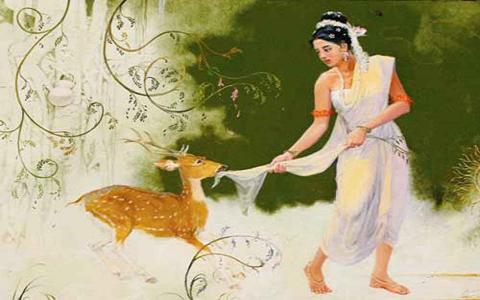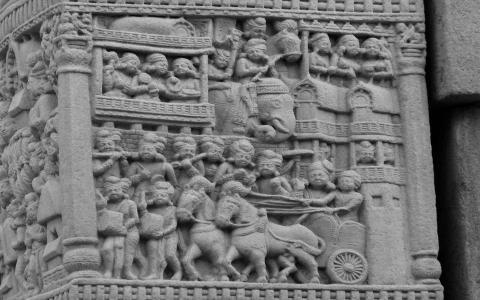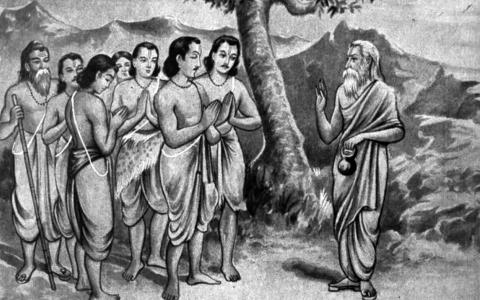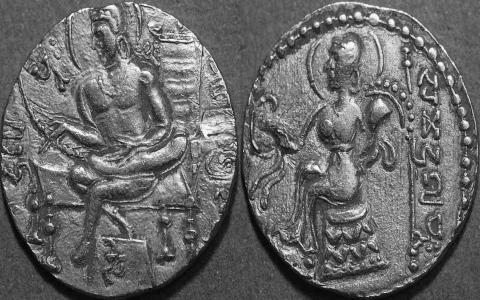March 2018

Sri. Hebbani Sheshacharya belonged to an era when thirty-five ounces (roughly a kilogram) of rice was available for just a rupee and six tender coconuts could be bought for a single paisa. He was highly learned in Sanskrit literature and Dvaita philosophy. He was already old when I first saw him. Even at that age, his personality was a sight to behold. And he spoke affectionately as well. That is the reason his memory is vivid in my mind.
The...

The irrational and the super-natural in the play
In Aristotle’s view, there should be nothing irrational (i.e., grossly contrary to what is plausible or intelligible – Stephen Halliwell [1]) in the events; if there is, it should lie outside the play (16: 5-6). It distracts the audience that is closely following the play and are convinced of the events, when a supernatural element suddenly intervenes. The staging of anything irrational, when...

ಆದರೆ ನಾವು ಇಂಥ ಆಂಶಿಕಸತ್ಯಗಳನ್ನೇ ಬೆಂಬತ್ತಿ ಬಸವಳಿಯುವುದು ಅನಪೇಕ್ಷಿತ. ಕೇವಲ ನಿರ್ವಿಶಿಷ್ಟಸಾರ್ವತ್ರಿಕಾನುಭವದ ತಿಳಿಬೆಳಕಿನಲ್ಲಿ ಎಲ್ಲ ಸತ್ತೆಗಳನ್ನೂ ಗಮನಿಸಿ ನಿರ್ಣಯಿಸೋಣ. ಭರತಮುನಿಯು ಹಾಸ್ಯರಸವನ್ನು ಆತ್ಮಸ್ಥ ಮತ್ತು ಪರಸ್ಥವೆಂದು ಇಬ್ಬಗೆಯಾಗಿ ವಿಂಗಡಿಸಿದ ಸಂಗತಿಯನ್ನು ಈಗಾಗಲೇ ನೋಡಿದೆವಷ್ಟೆ. ಆದರೆ ಈ ವಿಭಾಗದಲ್ಲಿ ನಗುವವನು ಮತ್ತು ನಗಿಸುವವನು ಎಂಬ ಎರಡು ಮುಖಗಳು ಮಾತ್ರ ತೋರುತ್ತಿವೆಯಲ್ಲದೆ ಮತ್ತೇನೂ ವಿಶಿಷ್ಟತೆಗಳಿಲ್ಲಿಲ್ಲ. ಮುಖ್ಯವಾಗಿ ಈ ವಿಭಾಗಕ್ರಮವು ದೃಶ್ಯಕಾವ್ಯವನ್ನು ಗಮನದಲ್ಲಿರಿಸಿಕೊಂಡಿದೆ. ನಗಿಸಲೆಂದೇ ನಿಶ್ಚಿತರಾದ...

ಹಾಸ್ಯವು ಸರ್ವಜನಮನೋಭಿರಾಮವಾದ ರಸ. ಇದನ್ನು ಕುರಿತು ಲಕ್ಷಣವಿವೇಚನರೂಪವಾಗಿ ಚಿರಂತನಭಾರತೀಯಕಾವ್ಯಮೀಮಾಂಸೆಯು ಹೆಚ್ಚಾಗಿ ಹೇಳದಿದ್ದರೂ ಇದರ ಪ್ರಾಮುಖ್ಯವನ್ನು ಲಕ್ಷ್ಯಾತ್ಮಕವಾಗಿ ನಮ್ಮ ಸಾಹಿತ್ಯಲೋಕವು ಚೆನ್ನಾಗಿಯೇ ಗುರುತಿಸಿದೆ. ಇದಕ್ಕೆ ಅಭಿಜಾತ-ಅನಭಿಜಾತ-ಆಧುನಿಕ-ಪ್ರಾಚೀನಾದಿ ಭೇದವಿಲ್ಲದೆ ಸರ್ವತ್ರ ಮಾನ್ಯತೆಯೇ ಸಂದಿದೆ. ಪಾಶ್ಚಾತ್ಯಸಾಹಿತ್ಯಜಗತ್ತಿನಲ್ಲಿ ಕೂಡ ಚಿರಂತನರಾದ ಅರಿಸ್ಟಾಟಲ್, ಲಾಂಜೈನಸ್, ಹೊರೇಸ್ ಮುಂತಾದವರು ಹಾಸ್ಯನಿರೂಪಣಕ್ಕೆ ಹೆಚ್ಚಿನ ಅವಧಾರಣೆಯನ್ನು ಹಾಕಿಲ್ಲವಾದರೂ ಅಲ್ಲಿಯ ಸಾಹಿತ್ಯವಿಸ್ತರವಾಗಲಿ, ಆಧುನಿಕರ ವಿವೇಚನೆಗಳಾಗಲಿ ಈ...

Buddha approved of and loved both the system of republics as well as the system of monarchy. He himself came from a republics establishment; he belonged to the Śākya-gaṇa. The republic that lay close to it was the Kolīya-gaṇa. There was a huge quarrel between the Śākya-gaṇa and the Kolīya-gaṇa with regard to sharing the waters of the River Rohiṇī.
Buddha was someone who saw firsthand the fights between the different republics. The people of the ...

The Pāṇḍavas wandered from one forest to another for several days.[1]
[Starting from Vāraṇāvata, they travelled through the provinces of Matsya, Trigarta, Pāñcāla, and Kīcaka. They were in the guise of tapasvis – with long matted hair, wearing barks of trees and kṛṣṇājina (deer-hide) for garments. They made use of the time to study the Vedas, the Vedāṅgas, and nīti-śāstras. They met their ancestor Vyāsa and offered their respects to him. Vyāsa...

Recognition and reversal (‘Anagnorisis’ and ‘Peripeteia’)
The crux of a tragedy lies in recognition and reversal. A simple plot is an action which is continuous and unitary, but whose transformation lacks reversal and recognition. A ‘complex’ plot is one whose transformation contains recognition or reversal or both. And these elements should emerge from the very structure of the plot, so that they ensue from the preceding events by necessity or...

DVG’s conception of a strong and prosperous Bharata was a mixture of Yoga and Kshema; Yoga in the sense of having an opportunity to obtain something and Kshema in the sense of retaining and sustaining it safely.
Blend and Balance
These ideals operate at the level of the Samashti (the nation and society) and act as guideposts for organizing and governing a nation and society. No matter however noble and lofty these ideals may be, they’re mere “...

One of the Kannada literary giants of the twentieth century, K V Puttappa (Kuvempu) once classified[1] literature as Sakaala (timely) and Trikala (timeless) literature. Given the innate nature of the medium, journalistic (news reports, opinion pieces, editorials, magazine essays) literature belongs to the former category. Yet, in the hands of masters, even this category of literature takes on a quality of timelessness. Instead of being buried...

Samudragupta had a wife named Dattadevi. Ramagupta and Chandragupta Vikramaditya were their sons. We are fortunate to know their names and other details from the coins that were minted in that era. A great economic, cultural, and social revolution took place in the Gupta Age. We can see in history how the span, the vastness, and the kṣātra (of the Gupta Age) protected people in all stages of life, from all walks of life.
A few accuse...
